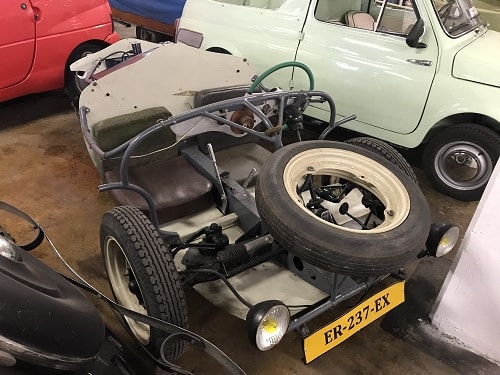
Bouffort Three-wheeler Prototype- ca. 1950
Victor Bouffort was known as a creative inventor, engineer, and developer of interesting vehicles and was a quizzical, forward-thinking man. He was commissioned by the French army just after...
DAILY DEMONSTRATIONS AT 11AM, FREE WITH ADMISSION!
Please note that the cars or exhibit items shown in this database are part of our collection but may not be on display when you visit.
Victor Bouffort was known as a creative inventor, engineer, and developer of interesting vehicles and was a quizzical, forward-thinking man. He was commissioned by the French army just after...
The 1954 Bradshaw Utility Estate, a post-war prototype vehicle, was the brainchild of England’s Granville Bradshaw. Bradshaw is credited for many innovative engine designs, specifically the ABC (All British...
The Göbel brothers of the Netherlands established Duckhunt Company in 1993. Dimitri Göbel is the engineering genius, and Iwan Göbel has the business expertise. This company specialized in servicing...
Dutch manufacturer Waaijenberg introduced this two-seat microcar, the Canta, in 1995. With its low step-in height and the availability of hand controls, the Canta was specifically created to ensure...
At the outset of World War II, as American automobile factories were switching from making cars to making tanks, planes, jeeps, and munitions, a few independent car companies remained...
The Castarede is a one-of-a-kind three-wheeler constructed by Pierre Castarede in post-WWII France. It utilizes a 1938 Gnome & Rhone motorcycle and the remains of an Amilcar. This beautiful...
The Caterham 7 Blackbird was launched in front of the world’s automotive press on July 8, 1999, at the F1 Circuit in Portugal, and the performance from this 1000cc...
In June 1973, Caterham cars took over production of the Lotus Seven. The move was a historic one and secured Caterham’s long-term future. Three decades, and ten thousand sales...
In 1961, Chevrolet introduced the Corvair 95 Greenbriar van and Rampside pickup. Using a shorter 95-inch wheelbase, the van and pickup expanded the Corvair model range now comprised of...
One of the most controversial cars to ever come from Detroit, the Corvair still sparks conversations and perpetuates myths to this day. With a ten-year production run and 1.8...
In 1953, Chevrolet introduced America to an all new, lightweight, fiberglass bodied, two-seat sports car they called Corvette. Corvette was introduced to compete with the overwhelming number of British...
This bare chassis gives an unrestricted view of the inner workings of the famous Citroën 2CV, or “Deux Chevaux”, including its longitudinal suspension, air-cooled 602cc engine, unusual shifter linkage,...
The “Skinny” 2CV, occasionally referred to as a 1CV, is essentially a standard 2CV that has been narrowed in size by half. While little is documented in regards to...
As far back as the early 1930s, Citroën teamed with Yacco, an oil company in France, for endurance testing on Citroën automobiles. These cars were tested at Montlhéry, a...
Twenty-five years after production began, the 2CV has been through minor changes. Compare the similarities and differences of this later model 2CV with the older grey 1954 2CV. Although...
Citroën wanted to create a four wheel drive car for use in Africa to take the rugged terrain encountered during oil and mineral exploration. Instead of going with a...
Citroën’s easily adaptable 2CV seemed to be a good starting point for French engineer Marc Voisin to create a true four-wheel drive offering. While the earlier 2CV Sahara had...
The 2CV “Fourgonnette” (or Truckette) played as important a part of the 2CV story as the car. Ultimately, over a million examples were built, which accounted for nearly a...
This car started as a stock Citroën 2CV. As the 2CV was found to be affordable and easy to maintain, it was an ideal car for enthusiasts to create...
The fire and rescue service in Cogolin, France, were using a Citroën 15-6 Traction Avant as part of their fleet. One night while on patrol, Colonel Hourcastagné found the...
This race car started as a stock Citroën 2CV. As the 2CV was found to be affordable and easy to maintain, it was an ideal fit with the racing...
The Citroën 2CV was designed to offer minimal-cost rural transportation. Designers were challenged to build a car that would carry two people and a 250 pound sack of potatoes...
The peoples’ car of France, originally developed before WWII, the 2CV did not go into production until 1950 because of the war. The press laughed at the car, claiming...
The Citroën 5CV was shown at the Paris Salon in 1921, and production began in 1922. For the first time in France, the marketing was slanted toward feminine clientele,...
André Citroën introduced his first car to the public in 1919, and within two weeks received 16,000 orders for the Type a 10CV. The company steadily grew through the...
The Citroën Ami 6 was launched in 1961 as “the world’s most comfortable medium class car.” The arrival of the Ami 6 filled the demand for Citroën to produce...
The Citroën Ami 8 was presented to the public at the Geneva Motor Show in March 1969. The Ami 8 was far more conventional in appearance than the Ami...